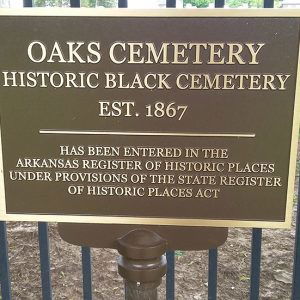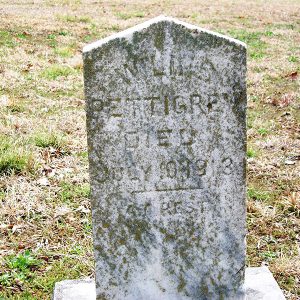calsfoundation@cals.org
Oaks Cemetery
Variously known over time as Twin Oaks, the African Cemetery, or the Colored Cemetery, Oaks Cemetery is a historic African American cemetery located adjacent to the National Cemetery in Fayetteville (Washington County). Oaks Cemetery is the only location specifically set aside for African American burials in the city. A large percentage of Black citizens who lived and died in Fayetteville in the decades after the Civil War are buried there. Founded in 1867, Oaks Cemetery was placed on the Arkansas Register of Historic Places on December 3, 2014.
There are 270 identifiable graves in Oaks Cemetery. An Arkansas Archeological Survey investigation of a small area in the eastern, older part of the cemetery found twelve unmarked graves, which leaves open the possibility that there are many more unmarked graves in Oaks Cemetery.
Local entrepreneur Stephen K. Stone and his wife, Amanda Stone, sold a 0.98-acre plot of land on the southern edge of the city to the Black community in Fayetteville on July 4, 1867, for ten dollars. The property was to be used “for the Colored peoples of Washington County.” In 1924, widow Emma J. Jones sold 0.5 acres of land, located to the west of the original purchase, for $200 to the “Trustees of the Colored Cemetery of the City of Fayetteville, Arkansas.” This acreage basically represents the middle third or center of the cemetery. On April 21, 1947, Roy and Louise Dunn sold 0.83 acres of land to the west of the two prior purchases of land in Oaks Cemetery. This property was sold for one dollar “and other valuable considerations” to the “Trustees for Oakland [sic] Cemetery (colored).” This acreage represents the western third of Oaks Cemetery and is the last purchase of land that makes up the present-day cemetery.
The cemetery trustees in 1947 were Labe Joiner, J. C. Hoover, C. C. Manuel, and A. Ollison (this group was also known as the Community Club). This represents the first time Oaks Cemetery was fully in the hands of the local Black community.
The earliest known birthdate of those buried in Oaks Cemetery is that of Margrett West (1819–1913). There are several burials of people born in the 1840s, including Fanny Denton (1844–1917), Henry Moore (1845–1922), Lucille Smith (1845–1912), William Taylor (1845–1912), and Ann York (1845–1928). Most likely, all of these people were enslaved at the beginning of their lives.
Two gravestones in Oaks Cemetery list fraternal organizations. William Taylor’s gravestone indicates his membership in an Oddfellows Lodge, “Golden Heart Lodge No. 2134.” The shared gravestone of Russell Blye and his wife, Pearl Blye, references the Order of the Eastern Star, a Masonic organization for both men and women. It is certain that many Black citizens of Fayetteville belonged to benevolent groups, but there is no indication of such on other gravestones.
Willis Pettigrew (?–1913) was enslaved by the Pettigrew family of the Farmington (Washington County) area. He was a fixture on the Fayetteville scene for nearly fifty years after the Civil War. He was known for delivering wares around town in an ox-driven cart and was featured in a well-known photograph called “The Old South,” along with four other formerly enslaved men: Sam Van Winkle, Charlie Richardson, Squire Jahagen, and Nick Clemmons. Pettigrew’s gravestone is located in the south-central section of Oaks Cemetery.
Brothers Ollie and Lem McPherson lie side by side in Oaks Cemetery. Ollie was a World War I veteran, serving in the Missouri 415th Reserve Service Battalion. He died in 1919 at Camp Riley (now Fort Riley), Kansas, presumably of the influenza pandemic. Lem McPherson was one of the first Black patrolmen in Fayetteville history. He was killed in the line of duty on April 28, 1928. For many years, Lem McPherson’s gravestone lay unmarked, but thanks to the caretakers of Oaks Cemetery, his location next to Ollie was identified and the Fayetteville Police Department was able to place a new stone honoring him.
There are other known veterans buried in Oaks Cemetery, including Jacob I. Carr (d. 1937), James C. Hoover (1896–1954), Lawrence Jenkins (1920–1951), Curtis Mahone Sr. (1934–1987), and Frank Smith (1896–1948). Three men lived long enough ago to have possibly served in the Civil War, although there is no evidence of such service: William Taylor (1845–1912), Jack Denton (1833–1908), and Henry Moore (1845–1922).
Fayetteville poet George Ballard, originally from the Cincinnati (Washington County) area, became well known for his nationally recognized poem upon the death of President Woodrow Wilson in 1924. In 1928, his cleverly titled collection of poems, Ozark Ballards, was published. Ballard rests in an unmarked grave in Oaks Cemetery.
For additional information:
Alison, Charles. Images of America: Fayetteville. Charleston, SC: Arcadia Publishing, 2011.
Brown, Kent. Fayetteville: A Pictorial History. Fayetteville: University of Arkansas Press, 1982.
Fayetteville History. https://www.fayettevillehistory.com/ (accessed November 10, 2021).
“Oaks Cemetery.” Arkansas Register of Historic Places registration form. On file at Arkansas Historic Preservation Program, Little Rock, Arkansas. Online at https://www.arkansasheritage.com/arkansas-register/oaks-cemetery (accessed November 10, 2021).
J. B. Hogan
Fayetteville, Arkansas










Comments
No comments on this entry yet.